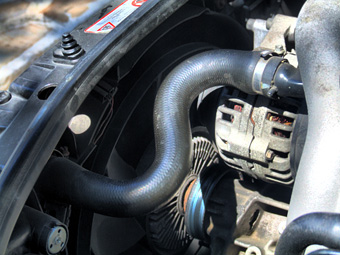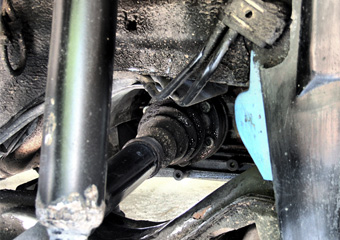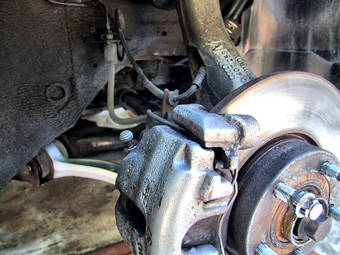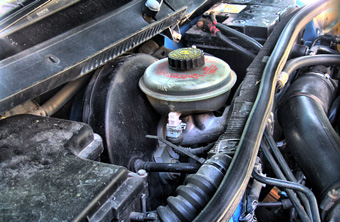
Check
the hoses entering and exiting the radiator for antifreeze
(coolant) leaks
 Check
the area where the driveshafts (cv axles) enter the gearbox
for leaks
Check
the area where the driveshafts (cv axles) enter the gearbox
for leaks
 Check
the brake lines entering the calipers for leaking brake
fluid
Check
the brake lines entering the calipers for leaking brake
fluid
 Power
steering fluid can be leaking from the pressurized metal
connections on the steering rack
Power
steering fluid can be leaking from the pressurized metal
connections on the steering rack
|
How to identify vehicle leaks
| TIPS
- When trying to track down leaks it can help to wipe
down the engine to get rid of excess dirt and debris.
It can also help to put a large white sheet of paper
under the vehicle overnight to highlight the location
of the leak - and also the quantity of liquid which
is emerging. |
|
When you start seeing random Jackson Pollock-like bits of artwork
mysteriously appearing on your garage floor or driveway it's time
to start looking for vehicle leaks. There's a number of different
fluids which can be seeping out, and they can come from a wide
variety of locations. However there are a few problem areas and
weak spots which are a good place to start looking.
Sometimes it can be hard to track down the source of a leak, especially
if the engine is dirty, as most are. Always check around - and most
importantly above - the area where you see fluid deposits, as the
liquid may have leaked from a different area, but pooled in a more
visible location.
Here's some good places to start looking, and a guide on what
the liquid might be.
Sump Oil - Engine oil may be leaking out of the drain plug
hole if the plug was incorrectly fitted or the gasket has failed.
Or it can be leaking from the sump gasket
itself. Both of these leaks are very low down on the engine so
will often not leave oil pooling anywhere on the engine - just
the floor. To check this location you'll have to get under the
vehicle and have a look around. Taking a small flashlight under
there will be helpful.
Oil from the Filter - Sometimes oil can be leaking from the
oil filter if it has been incorrectly fitted or has become loose
over time. The gasket may also have been damaged during installation.
If this is the source of the leak it's usually very easy to fix.
To check this area, locate the oil filter and look closely around
the point at which it screws into the engine block. If possible
wipe a clean cloth around the base of the filter and look for
fresh oil runs or deposits.
Transmission Fluid / Gearbox Oil - While engine oil is usually
the culprit of oily spots, it can also be gearbox oil. If gearbox
oil is the offending liquid, it usually finds its way out though
failed seals at the inboard ends of the driveshafts (CV axles).
Basically look around the area where the driveshafts enter the
gearbox on both sides and check for runs from this point. Also
check the underneath of the transmission/gearbox
to see if any other gaskets may have failed.
Antifreeze (Coolant) - Antifreeze
leaks are generally relatively easy to identify due to the distinctive
color - almost always either red or green - and the watery consistency
of the liquid. Leaking coolant often leaves white, powdery crystalline
deposits in the area, or areas, it is leaking from. Weak spots
in the cooling system which are a good place to start the leak
hunt are; around the water pump (check the pump's bearings and
gasket), the hoses entering and exiting the radiator,
around the thermostat
housing, and the radiator itself.
Brake Fluid - Brake fluid - on a dirty vehicle - can look
very similar to leaking engine oil. The key difference is the
areas in which the leaks will be found. Any leak found near the
wheel will almost certainly be brake fluid. Check the hoses entering
the brake calipers
and brake master and slave cylinders.
Power Steering Fluid - Power steering fluid is a hydraulic
fluid which may leak out of the pipe connections on the steering
rack. It can leak from other areas, but this is a good place to
start looking.
Fuel Leak - Fuel leaks are perhaps the most dangerous type
of vehicle leak. Fuel leaks generally make themselves known due
to the strong and distinctive odor. Fuel leaks, especially in
the engine bay can lead to a fire resulting in loss of the vehicle.
If a fuel leak is expected do not drive the vehicle - have it
towed immediately to a garage where a professionally can perform
a repair.
Any vehicle leak can turn into an expensive repair if it is not
repaired quickly. The liquids in a vehicle's engine are essential
to its operation. Low levels of oil or coolant can lead to overheating
and seizing of the engine - usually meaning a whole new engine
is needed. And it could have all been avoided for the price of
a five dollar gasket and 30 minutes of work - if you're lucky!
See also:
All Tutorials
How To Check Your Oil
How To Identify Vehicle Leaks
Basic Tire Maintenance
Take 10 Years Off Your
Car's Appearance
How to Perform a Heel-and-Toe Downshift
Left-Foot Braking
Driving on Snow and Ice
What is Torque?
What is a 'Monocoque'?
What are Superchargers?
|
|

